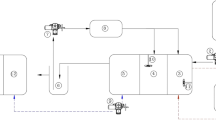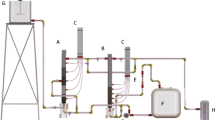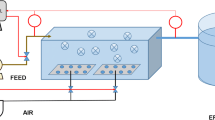Abstract
Industrial wastewater is one of the most significant environmental pollutants, and most industry owners shirk this responsibility due to the excessive expenses. Thus, the present research attempts to provide a suitable and highly efficient method with lower investment expenses in order to encourage industry owners to use this system and propose the best option for industrial wastewater treatment. The research aims to control water pollution, maintain ecosystem balance and reuse wastewater in industry. In this study, the process of reducing Nitrogen, Phosphorus, Total Suspended Solids and Chemical Oxygen Demand from wastewater with high Organic load has been investigated by fixed-bed sequencing batch reactors (biological, adsorption) with a volume of 24 L. The minimum and maximum system efficiencies were 43 and 88% in terms of Chemical Oxygen Demand for the removal of organic matter, 30 and 81% for the removal of Nitrogen, 88 and 99% for the removal of Phosphorus and 43 and 77% for removal of Total Suspended Solids, respectively. Anaerobic Filters system showed good efficiency for removing the organic matter, Nitrogen and Phosphorus from industrial wastewater with high organic load. Results show a very long Solids Retention Time for essential microorganisms in the decomposition of toxic and inhibitory compounds, absorption of shock loads or non-biodegradable toxic compounds, the possibility of higher volumetric loading compared to aerobic processes and lower cell mass efficiency followed by important economic and environmental benefits in relation to the recycling and disposal of the produced cell mass.






Similar content being viewed by others
References
Abou Elela SI, Ali MEM, Ibrahim HS (2014) Combined treatment of retting flax wastewater using Fenton oxidation and granular activated carbon. Arab J Chem 9(4):511–517
A. Ahmadpour, F. Khazaali, and S. Hermasinejad (2014) Evaluation of the performance of membrane bioreactors for the purification of industrial effluents, presented at the Second scientific conference of process engineering, Tehran
Akhlaghi M, Yousefi Kebria D, and Amini Rad H (2014) Dairy wastewater treatment with activated carbon granule method. National conference on water crisis solutions in Iran and Middle East, Shiraz, Hamayeshnegar scientific conferences center
Alizadeh R, Borgheie SM (2006) Using granular activated carbon in the carboniferous process to removal organic materials and color of the textile industry wastewater. Chem Chem Eng J Iran 25(3):21–28
Banat F, Al-Asheh S, Al-Anbar S, Al-Refaie S (2007) Microwave-and acid-treated bentonite as adsorbents of methylene blue from a simulated dye wastewater. Bull Eng Geol Env 66(1):53–58
Barzinmehr H (2016) Evaluation of the efficiency of continuous anaerobic-aerobic reactors with a fixed bed for the purpose of removing phosphorus from sewage masters civil faculty. Sharif University of Technology, Iran
Chaparro TR, Pires EC (2011) Anaerobic treatment of cellulose bleach plant wastewater: chlorinated organics and genotoxicity removal. Braz J Chem Eng 28(4):625–638
Geena GP, Georgette G, Krishna Priya S, Febin M, Nisha M (2016) Removal of dissolved solids in waste water using activated carbon from coconut shell. J Res 2(7):5–7
Gowon J, Okunola OJ, Uduma AU, Ali T, Hamisu S (2015) Treatment of waste water by activated carbon developed from Borassus Aethiopum. Niger J Mater Sci Eng 6:301–307
Gummas RH, Okpeke I (2015) Production of activated carbon and characterization from Snail Shell Waste (Helix Pomatia). Adv Chem Eng Sci 5:51–61
Hu J, Ong S, Ng W, Lu F, Fan X (2003) A new method for characterizing denitrifying phosphorus removal bacteria by using three different types of electron acceptors. Water Res 37:3463e3471
Latif M, Ahmad A, Ghufran R, Wahid Z (2012) Effect of temperature and organic loading rate on upflow anaerobic sludge blanket reactor and CH4 production by treating liquidized food waste. Environ Prog Sustain Energy 31(1):114–121
Leitão RC, Van Haandel AC, Zeeman G, Lettinga G (2006) The effects of operational and environmental variations on anaerobic wastewater treatment systems: a review. Bioresour Technol 97(9):1105–1118. https://doi.org/10.1016/j.biortech.2004.12.007
Meriç S, Selçuk H, Belgiorno V (2005) Acute toxicity removal in textile finishing wastewater by Fenton’s oxidation, ozone and coagulation–flocculation processes. Water Res 39(6):1147–1153
Mohan SV, Babu VL, Sarma P (2007) Anaerobic biohydrogen production from dairy wastewater treatment in sequencing batch reactor (AnSBR): Effect of organic loading rate. Enzyme Microb Technol 41(4):506–515
Mohd Udaiyappan AF, Abu Hasan H, Takriff MS, Sheikh Abdullah SR (2017) A review of the potentials, challenges and current status of microalgae biomass applications in industrial wastewater treatment. J Water Process Eng 20:8–21
Peng Y, Ge S (2011) Enhanced nutrient removal in three types of step feeding process from municipal wastewater. Bioresour Technol 102:6405e6413
Periyasamy P, Ramesh N (2016) Bio-kinetic analysis of tannery and sago effluents treated in UASB and HUASB reactor. Asian J Res Soc Sci Humanit 6(7):152–169
Rincón B, Borja R, González J, Portillo M, Sáiz Jiménez C (2008) Influence of organic loading rate and hydraulic retention time on the performance, stability and microbial communities of one-stage anaerobic digestion of two-phase olive mill solid residue. Biochem Eng J 40(2):253–261
Sappi (2012) Water use and treatment in the pulp and paper industry. Sappi Fine Paper North America 5:1–7
Tchobanoglous G, Burton F, Stensel HD (2013) Wastewater engineering: Treatment and reuse. 4th edn. McGraw-Hill
Tonon D, Tonetti A, Coraucci Filho B, Bueno D (2015) Wastewater treatment by anaerobic filter and sand filter: Hydraulic loading rates for removing organic matter, phosphorus, pathogens and nitrogen in tropical countries. Ecol Eng 82:583–589
Van Ginkel SW, Logan B (2005) Increased biological hydrogen production with reduced organic loading. Water Rese 39(16):3819–3826
Vignesh P, Seenirajan M E, Khadka B, Priyadarshi K, and Chandra Shah S (2017) Treatment of dairy wastewater using upflow anaerobic filter. SSRG International Journal of Mechanical Engineering, vol. ICCREST’ No. 17, Special Issue
Wiesner MR, Bottero J-Y (2017) Environmental nanotechnology: applications and impacts of nanomaterials, 2nd Edition. McGraw-Hill Education: New York, Chicago, San Francisco, Athens, London, Madrid, Mexico City, Milan, New Delhi, Singapore, Sydney, Toronto. ISBN: 780071828444.
Wijekoon KC, Visvanathan C, Abeynayaka A (2011) Effect of organic loading rate on VFA production, organic matter removal and microbial activity of a two-stage thermophilic anaerobic membrane bioreactor. Bioresour Technol 102(9):5353–5360
Acknowledgements
The authors would like to thank the Ghaemsazan Afra Company for financial support of this study in terms of plan number 2143010982 and Iranian Health Test Laboratory in order to provide laboratory facilities.
Author information
Authors and Affiliations
Corresponding author
Ethics declarations
Conflicts of interest
There is no conflict of interest.
Additional information
Editorial responsibility: Babatunde Femi Bakare.
Rights and permissions
About this article
Cite this article
Ansari Joveini, H., Javid, A., Hassani, A. et al. Investigation on removal of high organic load of industrial wastewater by cascade filters (bio-filters with different media). Int. J. Environ. Sci. Technol. 19, 1765–1774 (2022). https://doi.org/10.1007/s13762-021-03317-y
Received:
Revised:
Accepted:
Published:
Issue Date:
DOI: https://doi.org/10.1007/s13762-021-03317-y




